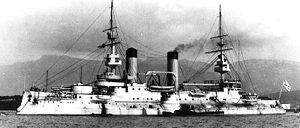Russian battleship Tsesarevich
 Tsesarevich moored | |
| Career | |
|---|---|
| Name: |
Tsesarevich (1901-1917) Grazhdanin (1917-1918) |
| Builder: | Compagnie des Forges et Chantiers de la Méditerranée à la Seine, France |
| Laid down: | 1 May 1899 |
| Launched: | 1900 |
| Commissioned: | 1901 |
| Decommissioned: | 1918 as hulk |
| Fate: | Scrapped 1924-1925 |
| General characteristics | |
| Type: | Battleship |
| Displacement: | 12,915 long tons (13,122 t) |
| Length: | 118.5 m (388 ft 9 in) |
| Beam: | 23.2 m (76 ft 1 in) |
| Draught: | 8.5 m (27 ft 11 in) |
| Propulsion: |
2 shaft, 4-cylinder Reciprocating vertical triple expansion (VTE) steam engines 20 coal-fired Belleville boilers 16,000 shp (12,000 kW) 1,350 tons coal |
| Speed: | 18.5 knots (21.3 mph; 34.3 km/h) |
| Range: | 5,500 nmi (10,200 km) at 10 knots (12 mph; 19 km/h) |
| Complement: | 744-803 |
| Armament: |
4 × 305 mm (12 in) guns (2×2) 12 × 152 mm (6 in) guns (12×1) 16 × 75 mm (3 in) guns 4 × 47 mm (1.9 in) 3-pounder guns 6 × 457 mm (18 in) torpedo tubes |
| Armour: |
Krupp armour Belt: 5.9–9 in (150–230 mm) Deck: 2.25 in (57 mm) Main turrets: 10 in (250 mm) Secondary turrets: 5.9 in (150 mm) Conning tower: 10 in (250 mm) |
The Russian battleship Tsesarevich (Цесаревич) was built in France by Compagnie des Forges et Chantiers de la Méditerranée à la Seine for the Imperial Russian Navy. She was named after the Tsesarevich - the title reserved for the eldest son of the Tsar and heir to the Russian throne. She was based in the Pacific and fought in the Russo-Japanese War, and was the flagship of Admiral Wilgelm Vitgeft in the Battle of the Yellow Sea. The Tsesarevich design was the basis of the Borodino-class battleships which were built in Russia.
Contents
Design
Ths ship was projected as part of the "Programme for the Needs of the Far East", authorised by Tsar Nicholas II in 1898. Warships were ordered from foreign yards because of capacity constraints in the Russian shipbuilding Industry. A draft specification was produced by the Marine Technical Committee (MTK) in Early 1898 and the French Shipyard, Compagnie des Forges et Chantiers de la Méditerranée à la Seine presented the Russians with a proposal. A contract was signed on 6 July 1898 at a cost of 280 thousand francs (11 355 thousand rubles).
Detailed design was done a combined team of French and Russian Engineers supervised by Captain Ivan Grigorovich. The construction was prolonged with several defective armour plates having to be replaced, however, upon completion, the Tsesarevich was the Russian Navy's best battleship prior to commencement of the Russo-Japanese War.[1]
Service life
The Tsesarevich was assigned to the Far East in December 1903, she was one of three ships to be struck by Japanese torpedoes during the attack on Port Arthur on 8 February 1904.
Battle of the Yellow Sea
On the morning of 10 August 1904, the First Pacific Squadron left Port Arthur to engage the Japanese fleet blockading the port. The Russian squadron consisted of the battleships Tsesarevich, Retvizan, Pobeda, Peresvet, Sevastopol and Poltava, along with four protected cruisers and 14 torpedo boats. The Japanese fleet, commanded by Admiral Togo, was made up of the battleships Mikasa, Asahi, Fuji, Shikishima, the armoured cruisers Nishin and Kasuga, as well as eight protected cruisers, 18 destroyers and 30 torpedo boats.
By midday, the main body of Japanese battleships attempted to block the Russians' path off the Shandong Peninsula. By 13:00 the first shots were fired, and during the one-hour fight the Russians succeeded in breaking out of the harbour. Admiral Togo began a long pursuit of the Russian fleet and gradually came up from the south-west, slowly overtaking the Russian battle line. At 16:20, the action resumed, with both sides trading artillery fire from ranges of 9,000 to 10,000 yards (10,000 m) and both sides receiving damage. At 18:00, with the battle's outcome still in question, Admiral Vitgeft was killed by a shell splinter on the bridge of the Tsesarevich. Just 12 minutes later, further hits on the Tsesarevich killed the captain and almost all bridge personnel as well as crippling the wheel. With the flagship's wheel wedged in place, the Tsesarevich went into such a sharp turn that it heeled over 12 degrees. Other ships in the line had not realized what was happening and followed suit, only for the fleet to turn in on itself, eventually losing battle line and scattering. With darkness approaching and low on ammunition, Togo broke off the engagement and retired eastward. He ordered a night attack against the Russian fleet by his destroyers and torpedo boats, but most of these attacks were repelled with light casualties.
While most of the Russian fleet (five battleships, a cruiser, and nine destroyers) returned to the safety of Port Arthur, the damaged Tsesarevich and three escorting destroyers sailed to Tsingtao, where they were interned.
Fate
At the end of the Russo-Japanese war the ship was transferred to the Baltic and saw action in World War I, taking part in the Battle of Moon Sound in 1917. After the Russian Revolution she was renamed Grazhdanin (Гражданин meaning Citizen). She was hulked in 1918 and scrapped in 1924 in Germany.
References
- ↑ Fordczyk, p. 18
- Forczyk, Robert. Russian Battleship vs Japanese Battleship, Yellow Sea 1904-05. 2009 Osprey. ISBN 978-1-84603-330-8.
- Tomitch, V. M., Warships of the Imperial Russian Navy (1968) Volume 1, Battleships
- From Conway's All the World's Fighting Ships 1860 - 1905, 1979
External links
See also
 Media related to Battleship Tsesarevich at Wikimedia Commons
Media related to Battleship Tsesarevich at Wikimedia Commons- Borodino-class battleship
| |||||||||||||||||||||||||||||
de:Zessarewitsch fr:Tsarevitch (cuirassé) ja:ツェサレーヴィチ (戦艦) pl:Cesarzewicz (1903) ru:Цесаревич (броненосец)
